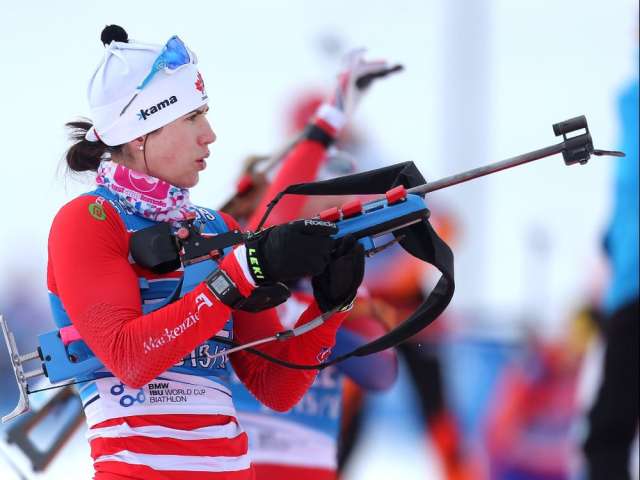Canadian biathletes carry extra motivation to replace Own The Podium funding that disappeared

When Julia Ransom takes aim, the butt of her .22-calibre biathlon rifle is nestled comfortably against her right shoulder.
So it must be the left one that has the chip on it.
“I was thinking about that. Chip on the shoulder. It’s definitely a good analogy,” said Ransom, who like other members of the Canadian national biathlon team, took it as a personal challenge when the performance-based, top-up money basically stopped flowing from Own The Podium this year, the final season before the PyeongChang Olympics.
Biathlon still received $1.25 million from OTP during the quadrennial, serious coin to be sure, but just $50,000 of that was delivered for the current season.
The national team program essentially paid the price for failing to reach a single international podium in 2016-17. The closest they came was a series of seventh-place finishes in relay events, Scott Gow’s 17th at a World Cup in Antholtz, Italy, and Ransom’s 18th at the world championships in Hochfilzen, Austria.
They weren’t exactly shooting blanks all over Europe, but they weren’t close enough to the podium to claim any ownership. The resulting financial reality hit home, and they are dealing with it as best they can.
“We have sort of spun this budget cut into a positive,” Ransom said. “At least, I’ve seen it as a positive. And whether that means an extra fire, a bit of an underdog mentality, I really think that has been shown.
“I’m obviously more in touch with the women’s side, and all of the ladies have stepped up their game and that was evident at the World Cup trials.”
The team that emerged from the trials earlier this month in Canmore, Alta., consists of brothers Scott and Christian Gow, Nathan Smith, Brendan Green, Ransom, Rosanna Crawford, Emma Lunder and Megan Bankes. They start the World Cup season Nov. 24 through Dec. 3 in Oestersund, Sweden. Another squad of eight senior athletes will compete Nov. 22 through 26 in Sjusjoen, Norway on the IBU Cup circuit.
They go their separate ways after a summer of training, spent mostly at the world-class Canmore Nordic Centre. They cut out all travel in an effort to conserve funds. They might otherwise have gone abroad to a training camp, certainly to Vermont for their annual summer competition against the United States.
But even with clipped wings, they have been able to spin that situation 180 degrees.
“This year we were home-based,” head coach Matthias Ahrens said. “It was actually good because we have a lot of senior athletes who have travelled a lot. Keeping them at home a bit more during the training season has actually helped for better recovery and having time with family.
“Luckily this training centre here, in my eyes, is one of the best in the world, if not the best. So in that regard we did not lose anything.”
Biathlon Canada general manager Andy Holmwood said they had to reduce staff and add duties to remaining personnel.
And they lost momentum last year, to be sure. Ahrens said Crawford and Green “under-performed,” while Smith, who was a consistent podium threat from in the 2014-15 and 2015-16 seasons, missed most of last season with a debilitating virus.
“It was an OK season; it wasn’t a disaster,” Ahrens said.
Rosanna Crawford during the 2015-16 season.
Off a good summer and solid trials, he sees medal potential from the men’s relay and from Smith. He tried to make the case for podiums this year and that the volatility inherent in biathlon got the best of the Canadian team and others last year.
For instance, the three men’s relay teams that hit the podium at worlds in 2016, Norway, Germany and Canada, were replaced by Russia, France and Austria last year.
He said OTP wasn’t buying that argument and didn’t come up with any funds for athletes heading to the Olympics in Korea. He understands the program’s mandate and appreciates the past financial support, but he finds it difficult to run a successful program from North America — travel costs to European World Cups and World Championships are immense — without the kind of guaranteed base funding that his German and Norwegian rivals are afforded. They did, however, receive $182,500 in next generation funding.
“I see the point that there should be some performance-based funding, no doubt, but at least every quad there should be some base funding we can rely on for consistency,” Ahrens said.
It could be argued successfully, of course, that other winter sport programs deliver consistent top-10, top-five or podium results every season and are rewarded by OTP with an attendant level of top-up funding each year.
Canada’s best biathletes were not at their best for much of the 2016-17 World Cup campaign. But they are well-trained and highly motivated to make a statement in the coming months.
“The spirit is there,” Ahrens said. “We want to prove that we belong where we see ourselves; that we have potential. I hope that we can prove it.”
• Email: dbarnes@postmedia.com | Twitter: @sportsdanbarnes





